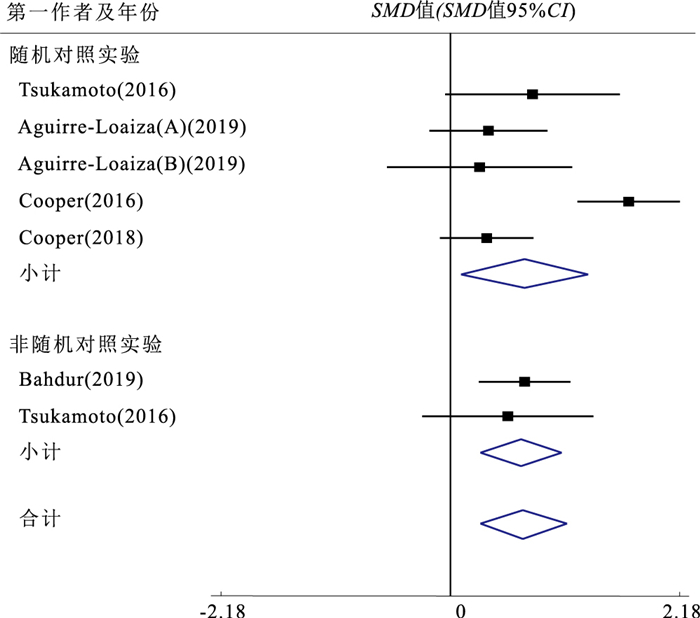Meta-analysis of effectiveness of high intensity interval training on cognitive executive function of adolescents
-
摘要:
目的 通过Meta分析探讨高强度间歇训练对青少年认知执行功能的影响,为医疗康复治疗和体育教育实践活动提供参考依据。 方法 以“高强度间歇训练”“认知功能”“执行功能”“High-Intensity Interval Training”“Cognition”“Cognition Function”“Executive Function”“Exercutive Controls”等关键词检索Pubmed、Cochrane library、Web of science、Embase、知网、万方和维普数据库,收集建库至2020年9月20日公开发表的关于高强度间歇训练对青少年认知执行功能影响相关的文献,运用Stata 14软件和Revman 5.3软件对纳入的10篇文献进行Meta分析,并采用固定效应模型或者随机效应模型进行效应量合并。 结果 急性高强度间歇运动后即刻Stroop测试反应时显著缩短(SMD=0.70,95%CI=0.28~1.11,z=3.29,P < 0.01);运动后30 min Stroop测试反应时变化无统计学意义(SMD=0.23,95%CI=-0.14~0.60,z=1.23,P>0.05);运动后即刻Stroop测试正确率显著提高(SMD=0.26,95%CI=0.03~0.50,z=2.21,P < 0.05);运动后30 min Stroop测试正确率变化无统计学意义(SMD=-1.38,95%CI=-4.28~1.52,z=0.93,P>0.05);长期高强度间歇训练干预后Stroop测试和连线测试反应时显著缩短(SMD=0.38,95%CI=0.07~0.70,z=2.41,P < 0.05)。 结论 急性与长期高强度间歇训练均可有效改善青少年的认知执行功能,但急性训练的后效应作用不明显。 Abstract:Objective To summarize the effective of high intensity interval training on cognitive executive function among adolescents through Meta-analysis, and to provide reference for medical rehabilitation and physical education practice. Methods Literature search was conducted for Chinese and English keywords "High-Intensity Interval Training", "Cognition", "Cognition Function", "Executive Function" and "Executive Controls" regarding the effect of high intensity interval training on cognitive executive function among adolescents published prior to September 20, 2020 in PubMed, Cochrane library, Web of science, Embase, the China National Knowledge Infrastructure (CNKI), the Wanfang database and the VIP database. Stata 14 software and Revman 5.3 software were used for Meta-analysis, fixed-effect or random-effect model was used to combine the Results based on the heterogeneity. Results The response time of Stroop test immediately after acute high intensity interval training significantly decreased (SMD=0.70, 95%CI=0.28-1.11, z=3.29, P < 0.01); there was no significant change in response time of Stroop test 30 min after training (SMD=0.23, 95%CI=-0.14-0.60, z=1.23, P>0.05); the correct rate of Stroop test immediately after acute high intensity interval training increased significantly (SMD=0.26, 95%CI=0.03-0.50, z=2.21, P < 0.05); there was no significant change in correct rate of Stroop test 30 min after training (SMD=-1.38, 95%CI=-4.28-1.52, z=0.93, P>0.05). After long-term high intensity interval training, the response time of Stroop and TMT test were significantly shortened (SMD=0.38, 95%CI=0.07-0.70, z=2.41, P < 0.05). Conclusion Acute and long-term high intensity interval training can effectively improve cognitive executive function among adolescents, but the long term effect of acute training is unclear. -
Key words:
- Physical education and training /
- Cognition /
- Growth and development /
- Meta-analysis /
- Adolescent
-
表 1 研究纳入文献的基本特征
Table 1. Basic characteristics of the literature included in this study
第一作者及年份 研究类型 样本量 运动方案/强度 持续时间 实验组干预前/后效应值 结局指标 实验组 对照组 即刻反应时 30 min后反应时 即刻正确率/% 30 min后正确率/% Tsukamoto(2016)[13] RCT 12 HIIT(~90%HRmax) 无 即刻测试 12 065±2 588/10 263±2 033 ms 12 065±2 588/10 866±2 442.2 ms 98.6±1.7/97.1±2.1 98.6±1.7/97.6±2.1 Stroop Bahdur(2019)[17] 非RCT(单臂) 44 HIIT 无 即刻测试 56.5±11.7/49.2±8.9 s 无 无 无 Stroop Aguirre-Loaiza(2019)[18] RCT 54/36 HIIT(76%~96%HRmax) 无 即刻测试 A: 73.4±14.3/68.7±11.8 s B: 67.7±16.5/64±8 s 无 A: 98.7±1.9/97.1±8.7 B:98.2±2.5/98.3±1.6 无 Stroop Cooper(2016)[14] RCT 44 HIIT[(181±13)次/min] 无 即刻测试 1 103±34/1 043±37 s 无 95.8±5.2/94.1±10.3 无 Stroop Cooper(2018)[19] RCT 39 HIIT[(197±9)次/min] 无 即刻测试 1 187±237/1 114±181 s 无 96.6±6.2/94.2±7.5 无 Stroop Tsukamoto(2016)[20] 非RCT(单臂) 12 HIIT(90% peak VO2) 无 即刻测试 10 592±2 414/9 336±2 148 s 10 592±2 415/9 902±2 383 ms 96.7±3.8/96.7±3.1 96.7±3.8/97.5±2.7 Stroop 张庆举(2020)[21] RCT 14 HIIT(~90%HRmax) 不干预 3次/8周 无 893.4±174.4/810.6±143.7 ms 无 无 Stroop Costigan(2016)[22] RCT 21/22 HIIT(74.04%,77.58%HRmax) 常规体育课 3次/8周 无 AEP:36.1±17.1/32.8±17.8 s RAP:39.9±17.0/32.8±18.6 s 无 无 TMT 张国晓(2019)[9] 非RCT(双臂) 23 HIIT 有氧持续训练 3次/6周 无 892.72±170.36/819.86±130.99 s 无 无 Stroop 唐浩轩(2019)[8] 非RCT(单臂) 33 HIIT(85%HRR) 无 即刻测试 无 1 176.4±1 144.7/1 028.1±1 209.2 ms 无 92.08±1.49/97.08±0.57 Stroop 注:TMT为连续测试,Stoop为Stoop测试;A组指对身体相对比较活跃的青少年进行干预(54个样本),B组指对身体活动不太活跃的青少年进行干预(36个样本);AEP组主要包括高强度的心肺运动,RAP组主要包括高强度的心肺和体重阻力训练。 -
[1] FUNAHASHI S. Neuronal mechanisms of executive control by the prefrontal cortex[J]. Neurosci Res, 2001, 39(2): 147-165. doi: 10.1016/S0168-0102(00)00224-8 [2] 蔡春先, 张运亮. 运动改善大脑执行功能机制的研究进展[J]. 成都体育学院学报, 2019, 45(6): 120-126. https://www.cnki.com.cn/Article/CJFDTOTAL-SORT201906021.htmCAI C X, ZHANG Y L. Research progress on the mechanism of exercise improving brain executive function[J]. J Chengdu Sport Univ, 2019, 45(6): 120-126. https://www.cnki.com.cn/Article/CJFDTOTAL-SORT201906021.htm [3] JANSSEN I, LEBLANCE A G. Systematic review of the health benefits of physical activity and fitness in school-aged children and youth[J]. Int J Behav Nutr Phys, 2010, 7 (1): 40-46. doi: 10.1186/1479-5868-7-40 [4] BULL F C, AL-ANSARI S S, BIDDLE S, et al. World Health Organization 2020 guidelines on physical activity and sedentary behaviour[J]. Br J Sports Med, 2020, 54(24): 1451-1462. doi: 10.1136/bjsports-2020-102955 [5] LEE T M C, WONG M L, LAU B W M, et al. Aerobic exercise interacts with neurotrophic factors to predict cognitive functioning in adolescents[J]. Psychoneuroendocrino, 2014, 39: 214-224. doi: 10.1016/j.psyneuen.2013.09.019 [6] 崔晨, 王小春, 解淳, 等. 急性有氧运动对超重青少年抑制功能效益的影响[J]. 西安体育学院学报, 2017, 34(2): 214-220. https://www.cnki.com.cn/Article/CJFDTOTAL-XATY201702013.htmCUI C, WANG X C, XIE C, et al. Effect of Acute Aerobic Exercise on the Inhibition of Overweight Adolescents[J]. J Xi'an Phys Educ Univ, 2017, 34(2): 214-220. https://www.cnki.com.cn/Article/CJFDTOTAL-XATY201702013.htm [7] 邢煜. 基于CiteSpace的高强度间歇训练研究的知识图谱分析[D]. 太原: 山西大学, 2020.XING Y. Knowledge Map Analysis of High Intensity Interval Training Research Based on Cite Space[D]. Taiyuan: Shanxi University, 2020. [8] 唐浩轩. 急性高强度间歇训练与中等强度持续训练对情绪体验与执行功能的影响[D]. 武汉: 武汉体育学院, 2019.TANG H X. Comparison of affective response and executive function between acute high-intensity interval training and moderate-intensity continuous training[D]. Wuhan: Wuhan Institute of Physical Education, 2019. [9] 张国晓. 高强度间歇训练对少年儿童身体素质及执行控制能力影响研究[D]. 济南: 山东师范大学, 2019.ZHANG G X. Research on the influence of high intensity interval training on children's physical fitness and executive control ability[D]. Jinan: Shandong Normal University, 2019. [10] KAO S, WESTFALL D R, SONESON J, et al. Comparison of the acute effects of high-intensity interval training and continuous aerobic walking on inhibitory control[J]. Psychophysiology, 2017, 54(9): 1335-1345. doi: 10.1111/psyp.12889 [11] 黎涌明. 高强度间歇训练对不同训练人群的应用效果[J]. 体育科学, 2015, 35(8): 59-75, 96. https://www.cnki.com.cn/Article/CJFDTOTAL-TYKX201508009.htmLI Y M. Effect of high-intensity interval training on different training populations[J]. Sports Sci, 2015, 35(8): 59-75, 96. https://www.cnki.com.cn/Article/CJFDTOTAL-TYKX201508009.htm [12] LEAHY A A, MAVILIDI M F, SMITH J J, et al. Review of high-intensity interval training for cognitive and mental health in youth[J]. Med Sci Sport Exer, 2020, 52(10): 2224-2234. doi: 10.1249/MSS.0000000000002359 [13] TSUKAMOTO H, SUGA T, TAKENAKA S, et al. Greater impact of acute high-intensity interval exercise on post-exercise executive function compared to moderate-intensity continuous exercise[J]. Physiol Behav, 2016, 155: 224-230. doi: 10.1016/j.physbeh.2015.12.021 [14] COOPER S B, BANDELOW S, NUTE M L, et al. Sprint-based exercise and cognitive function in adolescents[J]. Prev Med Rep, 2016, 4: 155-161. doi: 10.1016/j.pmedr.2016.06.004 [15] 李幼平, 杨克虎. 循证医学[M]. 北京: 高等教育出版社, 2014.LI Y P, YANG K H. Evidence-based medicine[M]. Beijing: Higher Education Press, 2014. [16] SLIM K, NINI E, FORESTIER D, et al. Methodological index for non-randomized studies (MINORS): development and validation of a new instrument[J]. Anz J Surg, 2003, 73(9): 712-716. doi: 10.1046/j.1445-2197.2003.02748.x [17] BAHDUR K, GILCHRIST R, PARK G, et al. Effect of HⅡT on cognitive and physical performance[J]. Apunts Sports Med, 2019, 54 (204): 113-117. [18] AGUIRRE-LOAIZA H, ARENAS J, ARIAS I, et al. Effect of acute physical exercise on executive functions and emotional recognition: analysis of moderate to high intensity in young adults[J]. Front Psychol, 2019, 10: 2774-2790. doi: 10.3389/fpsyg.2019.02774 [19] COOPER S B, DRING K J, MORRIS J G, et al. High intensity intermittent games-based activity and adolescents' cognition: moderating effect of physical fitness[J]. BMC Public Health, 2018, 18(1): 603-617. doi: 10.1186/s12889-018-5514-6 [20] TSUKAMOTO H, SUGA T, TAKENAKA S, et al. Repeated high-intensity interval exercise shortens the positive effect on executive function during post-exercise recovery in healthy young males[J]. Physiol Behav, 2016, 160: 26-34. doi: 10.1016/j.physbeh.2016.03.029 [21] 张庆举. 高强度间歇训练对12-14岁青少年脑执行功能的影响[D]. 济南: 山东大学, 2020.ZHANG Q J. Effect of high-intensity interval training on brain executive function of young people aged 12-14[D]. Jinan: Shandong University, 2020. [22] COSTIGAN S, EATHER N, PLOTNIKOFF R, et al. High intensity interval training on cognitive and mental health in adolescents[J]. J Sci Med Sport, 2017, 20: e108-e109. http://www.onacademic.com/detail/journal_1000039074626110_0d82.html [23] DALY-SMITH A J, ZWOLINSKY S, MCKENNA J, et al. Systematic review of acute physically active learning and classroom movement breaks on children's physical activity, cognition, academic performance and classroom behavior: understanding critical design features[J]. BMJ Open Sport Exerc Med, 2018, 4(1): e341-e357. http://europepmc.org/articles/PMC5884342/ [24] ALVES C R R, TESSARO V H, TEIXEIRA L A C, et al. Influence of acute high-intensity aerobic interval exercise bout on selective attention and short-term memory tasks[J]. Percept Motor Skills, 2014, 118(1): 63-72. doi: 10.2466/22.06.PMS.118k10w4 [25] LAMBRICK D, STONER L, GRIGG R, et al. Effects of continuous and intermittent exercise on executive function in children aged 8-10 years[J]. Psychophysiology, 2016, 53(9): 1335-1342. doi: 10.1111/psyp.12688 [26] MOREAU D, CHOU E. The acute effect of high-intensity exercise on executive function: a Meta-analysis[J]. Perspect Psychol Sci, 2019, 14(5): 734-764. doi: 10.1177/1745691619850568 [27] SLUSHER A L, PATTERSON V T, SCHWARTZ C S, et al. Impact of high intensity interval exercise on executive function and brain derived neurotropic factor in healthy college aged males[J]. Physiol Behav, 2018, 191: 116-122. doi: 10.1016/j.physbeh.2018.04.018 [28] KUJACH S, BYUN K, HYODO K, et al. A transferable high-intensity intermittent exercise improves executive performance in association with dorsolateral prefrontal activation in young adults[J]. Neur Image, 2018, 169: 117-125. http://d.wanfangdata.com.cn/periodical/ChlQZXJpb2RpY2FsRW5nTmV3UzIwMjEwMzAyEiBmM2QyYjBlNDg4YTA1MjFmZjcxZWEwZjQ5ZGY0ZmViMhoIajVybG1id2I%3D [29] WINTER B, BREITENSTEIN C, MOOREN F C, et al. High impact running improves learning[J]. Neurobiol Learn Mem, 2007, 87(4): 597-609. doi: 10.1016/j.nlm.2006.11.003 [30] TOTTORI N, MORITA N, UETA K, et al. Effects of high intensity interval training on executive function in children aged 8-12 years[J]. Int J Environ Res Public Health, 2019, 16(21): 4127. doi: 10.3390/ijerph16214127 [31] TRAVLOS A K. High intensity physical education classes and cognitive performance in eighth-grade students: an applied study[J]. Int J Sport Exerc Psy, 2010, 8(3): 302-311. doi: 10.1080/1612197X.2010.9671955 [32] STENMAN M, PESOLA A J, LAUKKANEN A, et al. Effects of two-week high-intensity interval training on cognition in adolescents: a randomized controlled pilot study[J]. Hum Movement, 2017, 18(2): 15-20. [33] COSTIGAN S A, EATHER N, PLOTNIKOFF R C, et al. High-intensity interval training for cognitive and mental health in adolescents[J]. Med Sci Sport Exer, 2016, 48(10): 1985-1993. doi: 10.1249/MSS.0000000000000993 [34] MOREAU D, KIRK I J, WALDIE K E. High-intensity training enhances executive function in children in a randomized, placebo-controlled trial[J]. eLife, 2017, 6: 1-26. http://www.ana.org.nz/wp-content/uploads/2017/08/elife-25062-v1-1.pdf [35] MARTINEZ-VIZCAINO V, ALVAREZ-BUENO C, CAVERO-REDONDO I, et al. MOVI-daFIT! Intervention: rationale and design of a cluster randomized controlled trial testing the effects on improving adiposity, cognition, and subclinical atherosclerosis by increasing cardiorespiratory fitness in children[J]. Medicine, 2019, 98(9): e14737. doi: 10.1097/MD.0000000000014737 [36] MEKARI S, EARLE M, MARTINS R, et al. Effect of high intensity interval training compared to continuous training on cognitive performance in young healthy adults: a pilot study[J]. Brain Sci, 2020, 10(2): 81-94. doi: 10.3390/brainsci10020081 [37] HSIEH S, CHUEH T, HUANG C, et al. Systematic review of the acute and chronic effects of high-intensity interval training on executive function across the lifespan[J]. J Sport Sci, 2021, 39(1): 10-22. doi: 10.1080/02640414.2020.1803630 [38] LUBANS D, RICHARDS J, HILLMAN C, et al. Physical activity for cognitive and mental health in youth: a systematic review of mechanisms[J]. Pediatrics, 2016, 138(3): e20161642. doi: 10.1542/peds.2016-1642 [39] DE GREEFF J W, BOSKER RJ, OOSTERLAAN J, et al. Effects of physical activity on executive functions, attention and academic performance in preadolescent children: a Meta-analysis[J]. J Sci Med Sport, 2018, 21(5): 501-507. doi: 10.1016/j.jsams.2017.09.595 -







 下载:
下载:






